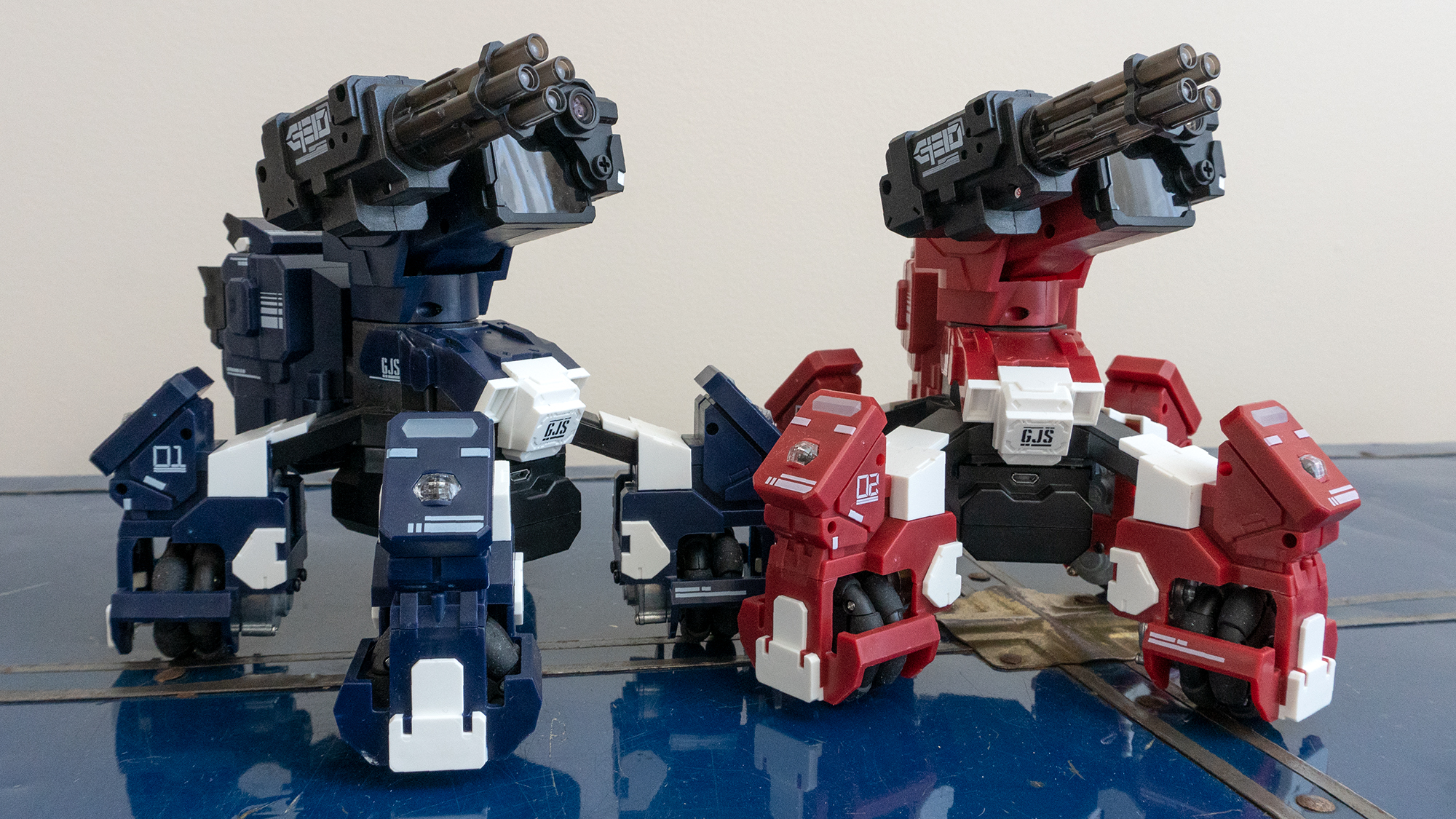It’s an unsettling glimpse into the inevitable future of warfare where battles are indistinguishable from video games, but watching a pair of robots duke it out is always entertaining. If your aspirations of one day rolling your competitor into the BattleBots arena have been thwarted by a complete lack of engineering skills, GJS’ Geio is an easy shortcut to some genuinely fun robo-combat; if you’re willing to splurge on a pair of them.

GJS Geio Gaming Robot
WHAT IS IT?
An app-controlled fighting robot toy.
PRICE
$US200 ($278), each.
LIKE
Incredibly fast and agile, battles can be a lot of fun if you have the space.
DISLIKE
Controlling the robots with touchscreen controls is a pain.
Editor’s Note: We don’t have local pricing or a release date as yet.
Outside of factories, the military, and cleaning floors, robot makers have had a hard time convincing consumers why they need a bot at home. As companions, security guards, smart assistants, or substitute pets; robots have so far failed to justify their existence. But GJS’ Geio doesn’t pretend to be anything other than a robot designed for make-believe combat. It’s a real-life equivalent of a video game mech, and while the weapons, sounds, and effects are all simulated during a battle in your living room, the overall experience ends up being more entertaining than just staring at a TV screen with a controller in hand.
Originally brought to market through a Kickstarter crowdfunding campaign, the foot-tall Geio robot looks and feels like a product from a large company that’s been making toys for decades. You’d swear you’ve seen its detailed, anime-inspired designed in a cartoon before, and it’s satisfyingly heavy thanks to a metal frame that provides rigidity and sturdiness as you’re driving it around and inevitably crashing into furniture.
It could almost pass as a painstakingly assembled model you’d leave untouched on a shelf when finished, but a power button brings the whole robot to life with flashing LEDs and a moving turret—complete with a spinning cannon—that quickly scans the room. Your smartphone or tablet running a free app serves as a wireless controller, scorekeeper, and a virtual lobby where you choose one of several game modes. The robots connect to your device using their own private wifi networks, but given there are just two models to choose from, I wish the default network names weren’t so cryptic. If you have one of each, you’ll probably want to immediately rename “Geio_7CDF60″ and “Geio_7149A4″ to “Geio_Blue” and “Geio_Red” so you can easily figure out which bot you need to connect to.
The Geio robot is surprisingly fast and agile—to the point of actually being too fast to control sometimes. It uses a set of four omnidirectional wheels that allow the robot to change directions quickly without having to make any steering adjustments. Driving one feels like controlling a character in a video game, with the ability to strafe side-to-side, and manoeuvre left, right, forward, and back without taking your crosshairs off your opponent. During a battle or race, you can pop into the settings at any time to adjust your robot’s overall speed, but the fastest option is only suitable for a large gymnasium or a very open space. In a small room, your robot will wildly careen around while you struggle to control it.
The Geio robot’s speed and agility wouldn’t be quite so intimidating if the toy included a physical controller. Touchscreen controls remain a challenging way to remotely steer and control a toy like this, even with a live-streaming first-person view—courtesy of a three-megapixel camera—of what the robot sees in your hands. Having to look away from the action to frequently re-position your hands on a virtual joystick is annoying, and even with motion-controlled steering turned on, piloting this robot without physical buttons is a challenge. I understand app controls are a cheaper solution for an already pricey toy, but an add-on physical controller would be a welcome option.
The Geio robot does manage to rise above its controller challenges by being genuinely fun to play with, but it’s one of those toys where having a friend, and a second robot, greatly increases its replay value. A single-player AR mode was recently introduced that incorporates the physical robot into a virtual battle that plays out on your phone or tablet. It uses a play mat, and tracking stickers stuck all over the bot so the app and your device’s camera can track the movements of the Geio in real-time. It’s well executed, but it still feels more like an afterthought for those who’ve only bought a single Geio robot. It left me wondering why I wouldn’t just play a dedicated robo-combat game while plopped in a comfy chair, instead of struggling to hold my phone out so the AR features could track the toy’s movements.
Driving the robot around on its own is entertaining for a while, as is pretending to shoot anything in its virtual cross-hairs, but as with most things in life, two is better than one. Battles are more enjoyable against another human-piloted Geio opponent, as are other game modes like racing or treasure-hunting that involves auto-detected tokens and power-ups you can place around your floors for an added challenge. When fighting another robot, the app tracks how much damage you’ve each taken, while vibrations and on-screen graphics let you know when you’re hit. It all very much feels like a video game, but there’s something slightly more satisfying about backing your actual robot behind a couch for protection or just ramming your opponent to score a hit.
Given it was a product born of a crowdfunding campaign, I’m impressed with what the Geio robot can do. Its unique omnidirectional wheels, which you commonly only see in industrial applications, work so well that I’m surprised more remote control toys haven’t adopted them. Unfortunately, touchscreen controls remain a disappointment, especially for a toy that’s as fast and agile as this one. But the bigger problem is that you’ll need to cough up $US400 ($557) for a pair of Geio robots to get the maximum enjoyment out of them.
README
-
Impressive build quality and detailing for a crowdfunded product.
-
Shockingly fast and agile. Given its size, it’s one of the fastest RC toys I’ve ever played with, and it can instantly change directions thanks to clever omnidirectional wheels.
-
The battery can be easily removed and charged with a micro USB cable, no proprietary cords needed.
-
Single-player AR Mode works, but the novelty wears off quickly.
-
$US200 ($278) isn’t cheap, but you’ll need to spend twice that to maximise the fun you can have with these bots.
